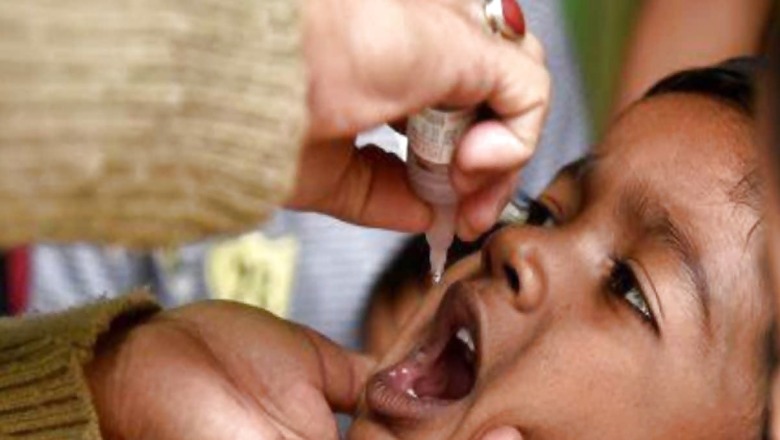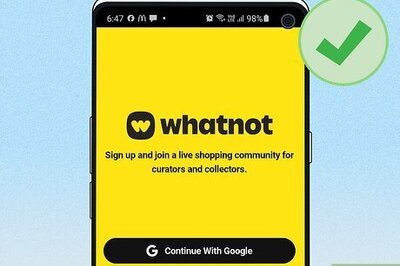
views
A nationwide Pulse Polio Immunisation drive to administer polio vaccine to children below the age of 5 will be conducted from March 3 (Sunday) in all districts. The preparation for the polio vaccination campaign drive is underway and health authorities in several have set up thousands of polio booths (mobile and non-mobile) and have been training volunteers for the administration of the oral polio vaccine to children.
As a part of the Centre’s Intensified Pulse Polio Immunization (IPPI) campaign 2024, several states, including Meghalaya and Goa, conducted polio awareness activities for almost a month.
Intensified Pulse Polio Immunization (IPPI) campaign kick start in #RiBhoi district with a rally participated by school students, to raise awareness on polio, the debilitating disease that can cause permanent paralysis, disability & even death.#PolioFreeIndia #PolioFreeMeghalaya pic.twitter.com/c4wtDqxYRO— Meghalaya Health (@meghalayahealth) February 29, 2024
Polio vaccines
Oral polio vaccine (OPV)
OPV produces antibodies in the blood and provides shield against all three types of poliovirus. In the event of infection, it protects the individual against polio paralysis by preventing the spread of poliovirus to the nervous system.
Polio vaccine distribution at PHC Shargole amid heavy snow fall. @MoHFW_INDIA pic.twitter.com/pRSlXCJkD6— NHM Ladakh (@NhmLadakh) March 2, 2024
Inactivated polio vaccine (IPV)
It is an injectable vaccine and can be either administered alone or along with other vaccines (e.g., diphtheria, tetanus, pertussis, hepatitis B, and Haemophilus influenza). Generally, three-spaced doses are given to generate adequate levels of seroconversion. A booster dose is added during late childhood for polio prevention.
Polio symptoms
Most people affected by poliovirus are asymptomatic and do not show any symptoms. While 1 out of 4 people suffering from polio develop mild symptoms like sore throat, fever, tiredness, nausea, headache, and stomach pain. A few people with this virus can develop serious complications of brain and spinal cords like meningitis, paralysis, or weakness in arms or legs.
Poliovirus exists in three distinct types: type 1, type 2, and type 3. Type 1 is the most prevalent and has the highest propensity to cause paralysis. While type 2 and type 3 have been successfully eradicated worldwide, type 1 persists in select regions.
Pulse polio drive
Pulse Polio is an immunisation campaign established by the Centre to eliminate poliomyelitis (polio) in India by vaccinating all children under the age of five years against the virtual disease. In India, vaccination against polio started in around 1972 with the Expanded Programme on Immunization (EPI). By 1999, it covered around 60% of infants, giving three doses of OPV to each.
In 1985, the Universal Immunization Programme (UIP) was launched to cover all the districts of the country. UIP became a part of the Child Survival and Safe Motherhood Programme (CSSM) in 1992 and the Reproductive and Child Health Program (RCH) in 1997. This programme led to a significant increase in coverage, up to 5%. The number of reported cases of polio also declined from thousands in 1987 to 42 in 2010.
In 1995, following the Global Polio Eradication Initiative of the World Health Organization (1988), India launched the Pulse Polio immunisation programme with Universal Immunization Program which aimed at 100% coverage.
On March 27, 2014, the World Health Organization (WHO) declared India a polio-free country, since no cases of wild polio have been reported for five years.
Here’s why you should vaccinate your child against polio.
- Preventing the spread of polio: Immunization is the most effective way to prevent the spread of the poliovirus. By ensuring that your child receives the recommended doses of the polio vaccine, you contribute to creating a protective barrier against the virus in the community.
- Eradicating polio globally: The commitment to polio immunization plays a vital role in the global effort to eradicate this disease. Through widespread vaccination campaigns, significant strides have been made, with several countries successfully eliminating polio. Continued vaccination efforts are essential to achieving a polio-free world.
- Protecting unvaccinated individuals: Immunization not only safeguards the vaccinated individuals but also helps protect those who cannot receive the vaccine, such as infants or individuals with certain medical conditions. This concept of community or herd immunity is a crucial aspect of preventing outbreaks.
- Long-term health and well-being: The consequences of polio can be severe and life-altering. By ensuring your child receives the recommended polio vaccinations, you are investing in their long-term health and well-being, minimizing the risk of enduring the debilitating effects of the disease.
- Economic benefits: Polio can place a significant economic burden on individuals, families, and communities. The costs associated with medical treatment, rehabilitation, and loss of productivity can be overwhelming. Immunization is a cost-effective strategy to prevent the financial strain caused by polio-related illnesses.















Comments
0 comment